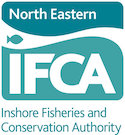Since the start of this project in February 2022 during the first 2 months we have been busy with getting material and equipment together, building 40 metal cages, filling them with cobbles and rigging them. We also had to decide where to deploy the cages and identified 10 suitable locations. The first 16 cages were deployed on the 23rd/24th May 2022 between Flamborough Head and Spurn Point (see map) followed by the deployment of 24 cages on the 8th/9th June 2022 between Flamborough Head and Hartlepool (see map). Now the cages have been deployed we will be monitoring them regularly during the summer period. Each survey site has 4 cages, and one is being hauled twice a month to record any settled organisms. We are mainly looking for early benthic stage lobsters, these are juvenile lobsters who have hatched this season and moved from their planktonic stage to the seabed. For the deployment and cage hauls we are using both, the North Eastern Guardian III (NEIFCA) and the RV Huntress (HFIG).
Alongside the regular cage hauls we are also undertaking plankton trawls to record the appearance and disappearance of planktonic lobster larvae. This in combination with temperature recordings will give us a better picture about the timings of the season and when we are expecting to see settled lobsters in the cages.
An additional part of this project is to get a better understanding of the age at size relationship in early-settlement lobsters. For this, berried lobsters were taken to the hatchery at the Yorkshire Marine Research Centre (HFIG) in April/May 2022. Early benthic lobsters (stage 4) will be measured and staged regularly throughout the summer season.
Since the deployment of the cages, a total of 14 cage hauls were done in June. We didn’t find any early-benthic stage lobsters in the cages, and we caught in the plankton trawls a few stage 1 and 2 lobster larvae. This is what we expected to see early in the hatching season. However, we did find a lot of other marine life already setting down in the cages. Some of the species we found were:
- Butterfish (Pholis gunnellus)
- Long Spined bullhead (Taurulus bubalis)
- Tadpole fish (Raniceps raninus)
- 3-bearded rockling (Gaidropsarus vulgaris)
- Squat lobster (Galathea dispersa)
- Brown shrimp (Crangon crangon)
Although the main priority of this project is to find early benthic stage lobsters and estimating their abundance, recording all the other species we are finding in the cages will provide us with better understanding of lobster habitat’s diversity and status.
The cage hauling, plankton tows and growth study in the hatchery will continue throughout this summer until the end of September/ beginning of October.
Figure 1: Position of all the ELSI cages in the NEIFCA district
